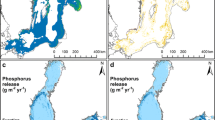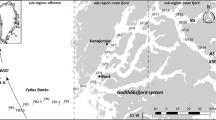Abstract
The large-scale distribution patterns of the estuarine spionid polychaetes Marenzelleria cf. viridis, Pygospio elegans, and Streblospio shrubsoli were studied in the Pomeranian Bay (southern Baltic Sea) at 20 stations in April 1993 and their relationship with hydrographic factors and sediment composition investigated. The densities of M. cf. viridis and S. shrubsoli decreased rapidly with increasing distance offshore. A corresponding decrease in phytoplankton concentration offshore is suggested as the main cause for the observed spatial patterns. P. elegans was more evenly distributed. At 10 selected stations further samples were collected between April 1993 and July 1996 to study the response of abundance and biomass of the three polychaetes to changes in environmental conditions and to investigate interspecific interactions within the macrofauna. Salinity, pelagic food supply, and sediment parameters did not change. At three of these stations redox potential of the sediment and macrofauna composition were affected by an unusual hypoxic/anoxic event in July/August 1994. All three spionid species were able to survive moderate seasonal hypoxic conditions, but died after exposure to severe anoxia. Special attention was focused on the re-establishment of the spionids. The rate with which M. cf. viridis and P. elegans re-colonised defaunated stations varied between a few weeks and two years. These differences in rate of re-establishment were attributed to the distance from undisturbed recruitment areas, and to the severity of the oxygen deficiency. Increasing densities of P. elegans and S. shrubsoli after the hypoxic event coincided with a reduced abundance of the bivalve Mya arenaria, suggesting a negative interspecific interaction.
Similar content being viewed by others
References
Arntz WE and Rumohr H (1982) An experimental study of macrobenthic colonization and succession, and the importance of seasonal variation in temperate latitudes. J Exp Mar Biol Ecol 64: 17–45
Beszczynska-Möller A (1995) The structure of the water mass and transport conditions in the Pomeranian Bay (Southern Baltic) in September 1993. Bulletin of the Sea Fisheries Institute, Gdynia-Poland 3: 5–14
Bick A and Arlt G (1993) The influence of Hediste diversicolor (O.F. Müller, 1776) on the macro-and meiozoobenthos of a shallow water area of Mecklenburg Bay (Western Baltic Sea), Rostocker Meeresbiolog Beitr 1: 9–24
Bick A and Burckhardt R (1989) Erstnachweis von Marenzelleria viridis (Polychaeta, Spionidae) für den Ostseeraum, mit einem Bestimmungsschlüssel der Spioniden der Ostsee. Mitt Zool Mus Berlin 65: 237–247
Bick A and Gosselek F (1985) Arbeitsschlüssel zur Bestimmung der Polychaeten der Ostsee. Mitt Zool Mus Berlin 61: 171–272
Bochert, R., 1996. Untersuchungen zur Reproduktionsbiologie von Marenzelleria viridis (Polychaeta, Spionidae) in einem flachen Küstengewässer der südlichen Ostsee. PhD-thesis, University Rostock, Shaker Verlag, Aachen, pp. 1–138
Bochert R and Bick A (1995) Reproduction and larval development of Marenzelleria viridis (Polychaeta, Spionidae). Mar Biol 123: 763–773
Brey T (1989) Der Einfluß physikalischer und biologischer Faktoren auf Struktur und Dynamik der sublitoralen Macoma-Gemeinschaft der Kieler Bucht. Ber Inst Meereskunde Kiel 186: 1–248
Cressie NAC (1991) Statistics for spatial data. John Wiley and Sons, Inc., New York
Dauer DM, Maybury CA and Ewing RM (1981) Feeding behaviour and general ecology of several spionid polychaetes from the Chesapeake Bay. J Exp Mar Biol Ecol 54: 21–38
Diaz RJ and Rosenberg R (1995) Marine benthic hypoxia: a review of its ecological effects and the behavioural responses of benthic macrofauna. Oceanogr Mar Biol Ann Rev 33: 245–303
Essink K and Kleef HL (1993) Distribution and life cycle of the North American spionid polychaete Marenzelleria viridis (Verrill, 1873) in the Ems Estuary. Neth J Aquat Ecol 27: 237–246
Fritzsche D and Von Oertzen J-A (1995) Metabolic responses to changing environmental conditions in the brackish water polychaetes Marenzelleria viridis and Hediste diversicolor. Mar Biol 121: 693–699
Fauchald K and Jumars PA (1979) The diet of worms: a study of polychaete feeding guilds. Oceanogr Mar Biol Ann Rev 17: 193–284
Fonselius S (1962) Hydrography of the Baltic deep basins, Fishery Board of Sweden, Ser Hydrogr 13: 1–41
Gosselck F and Georgi F (1984) Benthic recolonization of the Lübeck Bight (western Baltic) in 1980/81. Limnologica 15: 407–414
Hartmann-Schröder G (1996) Polychaeta. In: Dahl F (ed.), Die Tierwelt Deutschlands. 58 Teil. 2nd edition, Gustav Fischer Verlag, Jena, Stuttgart, Lübeck, Ulm
Helcom (1988) Guidelines for the Baltic Monitoring Programme for the third stage. Part D. Biological Determinants. Baltic Sea Environ. Proc. 27D
Hempel C (1957) Über den Röhrenbau und die Nahrungsaufnahme einiger Spioniden (Polychaeta, Sedentaria) der deutschen Küsten. Helgoländer Wiss Meeresunters 6: 100–135
Hines AH, Posey MH and Haddon PJ (1989) Effects of adult suspension-feeding bivalves on recruitment of estuarine infauna. The Veliger 32: 109–119
Jørgensen BB and Fenchel T (1974) The sulfur cycle of a marine sediment model system. Mar Biol 24: 189–201
Kube J (1992) Das Makrozoobenthos des Windwatts am Bock — Szenario des Jahres 1991. University Rostock (unpubl.), Diplomthesis, pp. 1–152
Kube J (1996) The ecology of macrozoobenthos and sea ducks in the Pomeranian Bay. Meereswiss Ber Warnemünde 18: 1–128
Kube J, Peters C and Powilleit M (1996) Spatial variations in growth of Macoma balthica and Mya arenaria (Mollusca, Bivalvia) in relation to environmental gradients in the Pomeranian Bay (Southern Baltic Sea). Arch Fish Mar Res 44: 81–93
Kube J, Powilleit M and Warzocha J (1996) The importance of hydrodynamic processes and food availability for the structure of macrofauna assemblages in the Pomeranian Bay (Southern Baltic Sea). Arch Hydrobiol 138: 213–228
Kube J, Zettler ML, Gosselck F, Ossig S and Powilleit M (1996) Distribution of Marenzelleria viridis (Polychaeta: Spionidae) in the southwestern Baltic Sea in 1993/94—ten years after introduction. Sarsia 81: 131–142
Leipe T, Neumann T and Emeis KC (1995) Schwermetallverteilung in holozänen Ostseesedimenten. Geowissenschaften 13: 470–478
Levin LA (1981) Dispersion, feeding behaviour and competition in two spionid polychaetes. J Mar Res 39: 99–117
Levin LA (1982) Interference interactions among tube-dwelling polychaetes in a dense infaunal assemblage. J Exp Mar Biol Ecol 65: 107–119
Llansó RJ (1991) Tolerance of low dissolved oxygen and hydrogen sulfide by the polychaete Streblospio benedicti (Webster). J Exp Mar Biol Ecol 153: 165–178
Nausch M (1982) Experimentell-ökologische Untersuchungen an Polychaetenspecies der Darss-Zingster Boddenkette. PhD-thesis, University Rostock, pp. 1–138
Nausch M (1984) The distribution of Streblospio shrubsoli, Alkmaria rom**i and Fabricia sabella and their resistance to temperature, oxygen deficiency and hydrogen sulphide. Limnologica 15: 497–501
Nausch M (1988) Untersuchungen zur Reproduktion von Alkmaria rom**i (Horst) und Streblospio shrubsoli (Buchanan). Wiss Z Univ Rostock 37(16): 47–50
Nehring D, Matthäus W, Lass H-U, Nausch G and Nagel K (1995) The Baltic Sea 1994—consequences of the hot summer and inflow events. Dt Hydrogr Z 47: 131–144
Noji CI-M and Noji TT (1991) Tube lawns of spionid polychaetes and their significance for recolonization of disturbed benthic substrates. Meeresforsch 33: 235–246
Ochocki S, Mackiewicz T, Nakonieczny J and Zalewski M (1995) Primary production, chlorophyll, and qualitative and quantitative composition of phytoplankton in the Pomeranian Bay. Bull Sea Fish Inst Gdynia-Poland 3: 33–42
Persson L-E (1983) Temporal and spatial variation in coastal macrobenthic community structure, Hanö Bay (southern Baltic). J Exp Mar Biol Ecol 68: 277–293
Pollehne F, Busch S, Jost G, Meyer-Harms B, Nausch M, Reckermann M, Schaening P, Setzkorn D, Wasmund D and Witek Z (1995) Primary production patterns and heterotrophic use of organic material in the Pomeranian Bay (Southern Baltic). Bull Sea Fish Inst Gdynia-Poland 3: 43–60
Powilleit M, Kube J, Maslowski J and Warzocha J (1995) Distribution of macrobenthic invertebrates in the Pomeranian Bay (Southern Baltic Sea) in 1993/94, Bull Sea Fish Inst Gdynia-Poland 3: 75–87
Renk H (1992) Primary production and the concentration of chlorophyll a. In: Trzosinska A (ed.), Marine pollution (2). An assessment of the effects of pollution in the Polish coastal area of the Baltic Sea. Polish Academy of Science, National Comitee on Oceanic Research, Studia i materialy oceanologiczne 61: 167–180
Rumohr H (1980) Der ‘Benthosgarten’ in der Kieler Bucht—Experimente zur Bodentierökologie. Reports SFB 95 55: 1–179
Sardá R and Martin D (1993) Populations of Streblospio (Polychaeta: Spionidae) in temperate zones: demography and production, J Mar Biol Ass UK 73: 769–784
Schmiedel-Anger V (1990) Sexuelle und asexuelle Fortpflanzung von Pygospio elegans (Polychaeta: Spionidae). PhD-thesis, University of Kiel, pp. 1–87
Schneider A (1994) Vorkommen von Schwefelwasserstoff in einem Brackwasserbiotop und sein Effekt auf die Sedimentbewohner dargestellt am Beispiel von Marenzelleria viridis. Erweiterte Zus Jahrestagung Deut Ges Limnol Hamburg 2: 680–684
Siegel H, Gerth M and Schmidt T (1996) Water exchange in the Pomeranian Bight investigated by satellite data and shipborne measurements. Continental Shelf Res 16: 1793–1817
Vismann B (1991) Sulfide tolerance: physiological mechanisms and ecological implications. Ophelia 34: 1–27
Winkler L (1888) The determination of dissolved oxygen in water. Ber Deut Chem Ges 21: 28–43
Zettler ML (1996) Successful establishment of the spionid polychaete Marenzelleria viridis (Verill, 1973), in the Darss-Zingst estuary (southern Baltic) and its influence on the indigenous macrozoobenthos. Arch Fish Mar Res 43: 273–284
Zettler ML, Bick A and Bochert R (1995) Distribution and population dynamics of Marenzelleria viridis (Polychaeta: Spionidae) in a coastal water of the southern Baltic. Arch Fish Mar Res 42: 209–224
Author information
Authors and Affiliations
Rights and permissions
About this article
Cite this article
Kube, J., Powilleit, M. Factors controlling the distribution of Marenzelleria cf. viridis, Pygospio elegans and Streblospio shrubsoli (Polychaeta: Spionidae) in the southern Baltic Sea, with special attention for the response to an event of hypoxia. Aquatic Ecology 31, 187–198 (1997). https://doi.org/10.1023/A:1009955505252
Issue Date:
DOI: https://doi.org/10.1023/A:1009955505252




